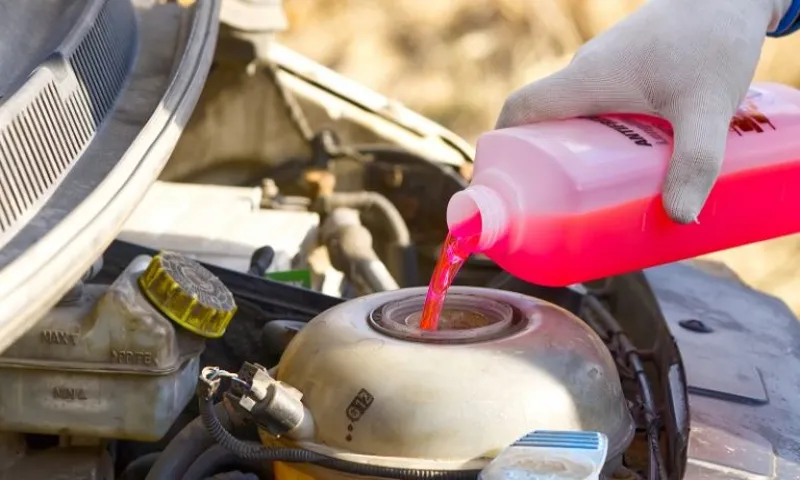Have you ever wondered what coolant temperature is and why it’s important for your vehicle? Well, think of your car’s engine as the heart of the vehicle, and the coolant temperature as its vital sign. Just like your body needs to maintain a consistent temperature to function properly, your engine also needs to be at the right temperature for optimal performance. Coolant temperature refers to the level of heat in the engine coolant, which is a mixture of water and antifreeze.
It is important because it helps regulate the temperature of the engine, preventing it from overheating or freezing. Maintaining the correct coolant temperature is crucial for several reasons. Firstly, a properly functioning engine operates most efficiently when it’s at its ideal temperature.
When the engine is too cold, it can lead to poor fuel combustion, increased fuel consumption, and excessive engine wear. On the other hand, when the engine becomes too hot, it can result in engine damage, reduced performance, and even complete engine failure. Monitoring the coolant temperature is also important for the longevity of your vehicle.
By ensuring that the engine is operating within the recommended temperature range, you can prevent premature wear and tear on engine components, such as the cylinders, pistons, and valves. In addition, coolant temperature is closely linked to the overall health of your vehicle’s cooling system. If the temperature rises too high, it can cause the coolant to boil or evaporate, leading to coolant loss and potentially causing the engine to overheat.
Conversely, if the temperature drops too low, the coolant can freeze, causing blockages in the cooling system and potential damage to the engine. To monitor the coolant temperature, most vehicles are equipped with a temperature gauge on the dashboard or a warning light that indicates when the engine is running too hot or too cold. Paying attention to these indicators and taking appropriate action can help prevent costly repairs and ensure the longevity of your vehicle’s engine.
In conclusion, coolant temperature plays a crucial role in the proper functioning and health of your vehicle’s engine. Maintaining the correct temperature helps optimize engine performance, prevents damage, and extends the lifespan of your vehicle. So, the next time you start your car, remember the importance of coolant temperature and keep an eye on that gauge to ensure a smooth and worry-free drive.
Table of Contents
Understanding Coolant Temperature
When it comes to coolant temperature, it’s important to understand what is considered normal for your particular vehicle. The temperature of your coolant can vary depending on factors such as the outside temperature, the engine load, and the speed you’re driving at. However, as a general rule of thumb, the coolant temperature should typically stay between 195 and 220 degrees Fahrenheit (90 to 105 degrees Celsius).
This range is considered optimal for most engines and ensures that the coolant is able to effectively absorb and dissipate heat. If your coolant temperature consistently falls below or exceeds this range, it may indicate a problem with your cooling system and should be inspected by a professional.
Definition of Coolant Temperature
coolant temperature, engine cooling system, radiator, overheating, efficient engine performance, temperature gauge, cooling fan, thermostat Understanding coolant temperature is crucial for maintaining the health and efficiency of your engine. In simple terms, coolant temperature refers to the temperature of the liquid coolant circulating through your engine’s cooling system. The cooling system plays a vital role in preventing your engine from overheating, which can lead to serious damage.
Think of the cooling system as your engine’s radiator. Just as a radiator helps to cool down the hot air in your car, the cooling system in your engine helps to cool down the heated parts of your engine. When your engine is running, it generates a lot of heat due to the combustion process.
The coolant, typically a mixture of water and antifreeze, absorbs this excess heat and carries it away from the engine. Monitoring the coolant temperature is essential because it gives you an indication of how well your engine is being cooled. Most cars have a temperature gauge on the dashboard that shows the current coolant temperature.
If the temperature starts to rise above the normal range, it could indicate a problem with the cooling system. Overheating can be caused by a number of factors, such as a malfunctioning cooling fan, a faulty thermostat, or low coolant levels. Maintaining the correct coolant temperature is crucial for efficient engine performance.
If the temperature gets too high, it can lead to a loss of power and decreased fuel efficiency. On the other hand, if the temperature is too low, the engine may take longer to reach its optimal operating temperature, resulting in poor performance and increased emissions. To keep your engine running smoothly, it’s important to regularly check your coolant levels and monitor the coolant temperature.
If you notice any abnormalities, such as the temperature gauge consistently reading high or fluctuations in temperature, it’s best to have your cooling system inspected by a professional mechanic. They can diagnose any issues and make the necessary repairs to ensure your engine stays cool and performs at its best. So, keep an eye on that temperature gauge and keep your engine running cool!

Importance of Monitoring Coolant Temperature
coolant temperature, monitoring coolant temperature, importance of monitoring coolant temperature, understanding coolant temperature
Ideal Coolant Temperature Range
“What temperature should coolant be?” is a common question among car owners, and for good reason. It’s important to maintain the ideal coolant temperature range to ensure optimal performance and prevent engine damage. The ideal coolant temperature range varies depending on the make and model of your vehicle, but generally, it falls between 190 and 220 degrees Fahrenheit (88 to 104 degrees Celsius).
This range allows the engine to operate efficiently while still providing adequate cooling. It’s crucial to avoid extreme temperatures, as running too hot can cause overheating and potential engine failure, while running too cold can impede fuel efficiency and lead to oil sludge formation. Keeping an eye on your coolant temperature gauge and performing regular coolant checks can help you maintain the correct temperature range and keep your engine running smoothly.
Recommended Coolant Temperature Range
coolant temperature range, ideal coolant temperature range
Factors Affecting Coolant Temperature
The ideal coolant temperature range is an important factor to consider for the proper functioning of a vehicle. Maintaining the right temperature is crucial as it directly affects the engine’s performance and longevity. Generally, the optimal coolant temperature range lies between 190°F to 220°F (88°C to 104°C).
Operating within this range ensures that the engine functions efficiently and minimizes the risk of overheating or freezing. Too low of a temperature can lead to poor fuel efficiency and increased emissions, while too high of a temperature can cause engine damage and reduce overall performance. It’s essential to monitor the coolant temperature and address any issues promptly to prevent potential damage to the vehicle.
Signs of Improper Coolant Temperature
One of the most crucial aspects of your vehicle’s health is maintaining the proper coolant temperature. But what temperature should your coolant be? Well, the ideal temperature for your coolant to be is around 195 to 220 degrees Fahrenheit (90 to 105 degrees Celsius). If your coolant is running at a lower temperature, it could indicate a problem with your thermostat or cooling system.
On the other hand, if your coolant is running at a higher temperature, it may be a sign of an overheating engine or a faulty radiator. So, it’s essential to keep an eye on your coolant temperature gauge and take action if you notice any abnormalities. Remember, your coolant temperature is like the Goldilocks of your vehicle’s engine – not too hot, not too cold, but just right.
Overheating
overheating, coolant temperature, signs, improper, burst radiator hose When it comes to our vehicle’s coolant temperature, it’s crucial to know the signs of improper levels. One of the most common indicators is an overheating engine. This can happen for several reasons, such as a malfunctioning radiator fan, a coolant leak, or a burst radiator hose.
Imagine your vehicle’s cooling system as its own personal air conditioning unit. Just like when the AC in your house starts blowing warm air, it’s a sign that something is amiss. The same goes for your vehicle.
If you start noticing that your engine is running hotter than usual or the temperature gauge is creeping into the red zone, it’s a clear indication that the coolant is not doing its job. Ignoring these signs can lead to severe engine damage, so it’s essential to address the issue promptly. Regularly checking your coolant levels and inspecting for leaks or burst radiator hoses can help prevent this overheating nightmare.
Underheating
underheating, coolant temperature, signs, improper, engine damage
How to Check Coolant Temperature
Are you wondering what temperature coolant should be at? Checking the coolant temperature is an important part of maintaining your vehicle’s engine health. When it comes to coolant temperature, there is a specific range that is considered normal. Typically, the coolant temperature should be between 195 and 220 degrees Fahrenheit (90 and 105 degrees Celsius).
This range allows the coolant to effectively regulate the engine temperature and prevent overheating. To check the coolant temperature, you can use a temperature gauge on your dashboard or a scan tool if your vehicle is equipped with one. It’s essential to keep an eye on the coolant temperature and address any issues promptly to avoid engine damage.
If the coolant temperature exceeds the normal range, it may indicate a problem with the cooling system, such as a malfunctioning thermostat or radiator. It’s best to consult with a mechanic to diagnose and repair any coolant temperature issues to ensure the continued performance of your vehicle.
Using a Temperature Gauge
temperature gauge, check coolant temperature
Using an OBD-II Scanner
OBD-II scanners are handy tools that can give you valuable information about your car’s performance and help you diagnose any issues. One important parameter you can check using an OBD-II scanner is the coolant temperature. Monitoring the coolant temperature is crucial because it can indicate if your car’s engine is operating at the right temperature or if it is overheating.
An overheating engine can lead to serious damage and costly repairs, so it’s essential to keep an eye on the coolant temperature. To check the coolant temperature using an OBD-II scanner, you’ll need to plug the scanner into the OBD port, usually located under the dashboard. Once connected, you can access the coolant temperature data on the scanner’s display.
The coolant temperature should be within the normal range specified by the manufacturer. If it’s too high, it may indicate a problem with the cooling system, such as a faulty thermostat or a coolant leak. On the other hand, if the coolant temperature is too low, it could mean that the thermostat is stuck open or that there is a problem with the engine’s temperature sensor.
Either way, it’s important to address these issues promptly to prevent further damage to your car’s engine. So, the next time you’re curious about your car’s coolant temperature, grab an OBD-II scanner, and with a few simple clicks, you can have the information you need to keep your engine running smoothly.
Maintaining Optimal Coolant Temperature
“What temperature should coolant be?” is a common question among car owners who want to ensure their engine is running at its best. The optimal coolant temperature for most cars is around 195 to 220 degrees Fahrenheit (90 to 105 degrees Celsius). This range allows the engine to operate efficiently and prevents overheating.
When the coolant temperature is below this range, the engine may not reach its optimal operating temperature, which can lead to reduced fuel efficiency and increased wear on engine components. On the other hand, if the coolant temperature exceeds the recommended range, it could indicate a problem with the cooling system, such as a malfunctioning thermostat or radiator. Regularly monitoring the coolant temperature is important to spot any potential issues and maintain the optimal temperature range for your car’s engine.
Checking Coolant Levels
coolant levels, maintaining optimal coolant temperature, checking coolant levels
Flushing and Refilling the Coolant
“Flushing and Refilling the Coolant: Maintaining Optimal Coolant Temperature” Flushing and refilling the coolant in your vehicle is an important maintenance task that helps to ensure optimal coolant temperature. The coolant, also known as antifreeze, plays a crucial role in keeping your engine cool and preventing overheating. Over time, the coolant can become contaminated with debris, rust, and other impurities, which can hinder its ability to properly cool the engine.
Flushing the coolant involves removing the old coolant and replacing it with fresh coolant, effectively removing any build-up and restoring peak performance. By maintaining optimal coolant temperature, you can prevent engine damage and costly repairs down the line. So, don’t neglect your coolant – take the time to flush and refill it regularly to keep your engine running smoothly.
Inspecting Cooling System Components
cooling system components, maintain optimal coolant temperature
Conclusion
So, what temperature should coolant be? Well, you see, coolant is like the Goldilocks of your car’s engine – it has to be just right! Too hot, and it’s like drinking a scalding cup of coffee on a hot summer day. Too cold, and it’s like sipping on a lukewarm soda that’s lost its fizz. The ideal temperature for coolant is like finding the perfect balance between comfort and efficiency.
It needs to be hot enough to keep your engine running smoothly, yet cool enough to prevent any overheating or damage. It’s a delicate dance, really, like trying to balance on a tightrope while juggling flaming torches. But fear not, dear driver, for your trusty coolant system is designed to handle this temperature tightrope act with finesse.
It circulates through your engine, absorbing all that excess heat and whisking it away to be radiated off into the atmosphere. It’s like having your own personal cooling squad, always ready to keep your engine from melting into a puddle of regret. So, the next time someone asks you what temperature your coolant should be, just give them a sly smile and reply, “Well, my friend, it should be just right – not too hot, not too cold, but like a refreshing breeze on a sunny day.
” And who knows, maybe your witty explanation will make them appreciate the complex art of coolant temperature management just a little bit more.
FAQs
What temperature should coolant be?
The ideal temperature for coolant in most vehicles is typically between 195 to 220 degrees Fahrenheit.
Why is it important to monitor the temperature of coolant?
Monitoring the coolant temperature is crucial as it helps identify potential engine issues such as overheating or a faulty thermostat.
Can coolant temperature affect engine performance?
Absolutely. If the coolant temperature is too low, the engine may experience reduced fuel efficiency and increased emissions. On the other hand, if the coolant temperature is too high, it can lead to overheating and possible engine damage.
How can I check the coolant temperature?
The coolant temperature can be checked using a diagnostic scanner or by observing the temperature gauge on the dashboard. It is important to ensure accurate readings by using the correct equipment and following the manufacturer’s instructions.
What are the consequences of insufficient coolant temperature?
Insufficient coolant temperature can lead to inefficient engine operation, increased wear and tear, and potential damage to engine components. It can also affect the performance of the heating system in the vehicle.
Are there specific coolant temperature ranges for different vehicles?
Yes, different vehicles may have slightly different recommended coolant temperature ranges. It is essential to refer to the vehicle’s owner’s manual or consult a mechanic to determine the specific range for your vehicle.
How often should I check the coolant temperature?
It is recommended to check the coolant temperature periodically or during regular maintenance intervals. Additionally, it is crucial to monitor the temperature when experiencing any signs of engine overheating or coolant-related issues.



